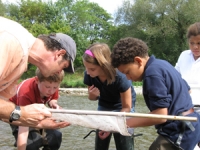One student sets her net in the water facing upstream, as others twist their feet on the river bottom to kick up dirt clouds in the water. As the invertebrates are loosened from the rocks, they flow with the current into the net. It seems like all distractions disappear once the students get into the water and search for these little animals. They are focused on the task at hand: find tons of water creatures.
The first net is always the most interesting. The kids are unsure of what to look for so when they realize those small and squirmy creatures are damselfly nymphs, caddisfly larvae and other macroinvertebrates, they are intrigued and ready for more. And when a group finds a crayfish, all the other groups join the hunt to look for more “small lobsters.”
I enjoy this program because the attitudes of the kids change within minutes. Not everyone is certain about the squirmy “bugs,” but they all seem content exploring. While I was helping a group of water explorers this fall, I pointed out that the brown invertebrate with a sucker was a leech. The initial reaction of the young girl holding the net was to scream and drop the net into the river. After some encouraging words, she was daring enough to touch it, tentatively grab it, and then as quickly as possible drop it into her group’s bin. A mixture of screaming and laughing filled the air. In less than a minute, this girl moved from fear to understanding. From “I’ll never touch that!” to “Let’s go find some more!”
A scene like this is replicated every day in different habitats at the Urban Ecology Center: climbing on a tree, flipping over logs, digging in compost. The simple act of exploration transforms kids into scientists as they make their own observations, draw their own conclusions, and face their fears in a safe environment. Kids naturally move from discomfort to comfort as they spend more time outdoors. In these natural environments, students can wonder, imagine and question. Through their interest, learning becomes easy, organic. Each school year I am reminded that it’s the little, simple moments (like experiencing the slimy texture of a leech) that can make the biggest impact.





